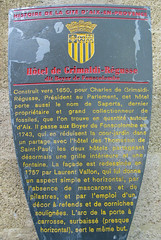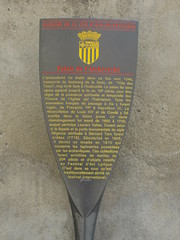Laurent Vallon
Commemorated on 2 plaques
Hôtel de Grimaldi-Régusse dit Boyer de Fonscolombe Construit vers 1650, pour Charles de Grimaldi-Régusse, Président au Parlement, cet hôtel porte aussi le nom de Saporta, dernier propriétaire et grand collectionneur de fossiles, que l'on trouve en quantité autour d'Aix. Il passe aux Boyer de Fonscolcombe en 1743, qui en réduisent la cour-jardin dans un partage avec l'hôtel des Thomassin de Saint-Paul, les deux hôtels partageant désormais une grille intérieure et une fontaine. La façade est redessinée en 1757 par Laurent Vallon, qui lui donne un aspect simple et horizontal, par l'absence de corniches soulignées. L'arc de la porte à carrosse, surbaissé (presque horizontal), sert le même but.
English translation: Built in 1650 for Charles de Grimaldi-Régusse, President of the Parliament, this hotel is also named after Saporta, the last owner and collector of fossils, which is found in quantities around Aix. It passes to the Boyer de Fonscolcombe in 1743, which reduce the courtyard garden in a sharing with the hotel Thomassin of Saint-Paul, both hotels now sharing an internal gate and a fountain. The facade is redesigned in 1757 by Laurent Vallon, which gives it a simple and horizontal aspect, by the absence of underlined cornices. The bow of the carriage door, lowered (almost horizontal) serves the same purpose.
Rue Gaston de Saporta, Aix-en-Provence, France where they redesigned facade
Palais de l'Archevêché L'archevêché fut établi dans ce lieu vers 1340, transporté du faubourg de la Seds, dit "Ville des Tours", trop isolé face à l'insécurite. Le Palais fut sans cesse agrandi jusqu'à la fin du 18e siècle, pour être digne de la puissance spirituelle et temporelle des Princes de l'église qui l'habitaient. Tous les souverains français de passage à Aix y furent logés, de François 1er à Napoléon III. La réconciliation de Louis XIV et de Condé y fut scellée dans le Salon jaune. Un vaste réaménagement fut mené de 1650 à 1730, auquel participa Laurent Vallon. Durant celluici la façade et la porte monumentale de style Régence attribuée à Bernard Toro furent créées (1715). Sécularisé en 1905, il devint un musée en 1910 qui conserve les tapisseries possédées par les archevêques. Ces collections furent enriches de textiles du 20e siècle et d'objets relatifs au Festival d'Art Lyrique. C'est dans sa cour qu'est traditionnellement abrité ce festival international.
English translation: Palace of the Archbishop The archbishop was established in this place around 1340, transported from the suburb of the Seds, called “City of Tours”, too isolated in the face of the insecurity. The Palace was constantly enlarged until the end of the 18th century, to be worthy of the spiritual and temporal power of the Princes of the Church who inhabited it. All the French rulers passing through Aix were housed there, from Francis 1st to Napoleon III. The reconciliation of Louis XIV and Condé was sealed in the Yellow Salon. A major redevelopment was carried out from 1650 to 1730, in which Laurent Vallon participated. During cellici the façade and the monumental Regency-style door attributed to Bernard Toro were created (1715). Secularized in 1905, it became a museum in 1910 that preserves the tapestries owned by the archbishops. These collections were enriched with 20th century textiles and objects related to the Lyric Art Festival. This international festival is traditionally housed in its courtyard. [AWS Translate]
Musée des Tapisseries - Palais de l'Archevêché - Place des Martyrs de la Resistance, Aix-en-Provence, France where they redeveloped


